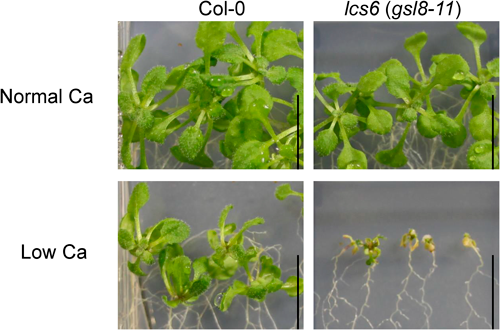- 著者
- Bera Subhankar Katsushi Yamaguchi Shuji Shigenobu Koh Aoki
- 出版者
- Japanese Society for Plant Biotechnology
- 雑誌
- Plant Biotechnology (ISSN:13424580)
- 巻号頁・発行日
- vol.38, no.2, pp.187-196, 2021-06-25 (Released:2021-06-25)
- 参考文献数
- 41
- 被引用文献数
- 8
Parasitic plants exchange various types of RNAs with their host plants, including mRNA, and small non-coding RNA. Among small non-coding RNAs, miRNA production is known to be induced at the haustorial interface. The induced miRNAs transfer to the host plant and activate secondary siRNA production to silence target genes in the host. In addition to interfacial transfer, long-distance movement of the small RNAs has also been known to mediate signaling and regulate biological processes. In this study, we tested the long-distance movement of trans-species small RNAs in a parasitic-plant complex. Small RNA-Seq was performed using a complex of a stem parasitic plant, Cuscuta campestris, and a host, Arabidopsis thaliana. In the host plant’s parasitized stem, genes involved in the production of secondary siRNA, AtSGS3 and AtRDR6, were upregulated, and 22-nt small RNA was enriched concomitantly, suggesting the activation of secondary siRNA production. Stem-loop RT-PCR and subsequent sequencing experimentally confirmed the mobility of the small RNAs. Trans-species mobile small RNAs were detected in the parasitic interface and also in distant organs. To clarify the mode of long-distance translocation, we examined whether C. campestris-derived small RNA moves long distances in A. thaliana sgs3 and rdr6 mutants or not. Mobility of C. campestris-derived small RNA in sgs3 and rdr6 mutants suggested the occurrence of direct long-distance transport without secondary siRNA production in the recipient plant.
- 著者
- Bera Subhankar Katsushi Yamaguchi Shuji Shigenobu Koh Aoki
- 出版者
- Japanese Society for Plant Biotechnology
- 雑誌
- Plant Biotechnology (ISSN:13424580)
- 巻号頁・発行日
- pp.21.0121a, (Released:2021-06-01)
- 参考文献数
- 41
- 被引用文献数
- 8
Parasitic plants exchange various types of RNAs with their host plants, including mRNA, and small non-coding RNA. Among small non-coding RNAs, miRNA production is known to be induced at the haustorial interface. The induced miRNAs transfer to the host plant and activate secondary siRNA production to silence target genes in the host. In addition to interfacial transfer, long-distance movement of the small RNAs has also been known to mediate signaling and regulate biological processes. In this study, we tested the long-distance movement of trans-species small RNAs in a parasitic-plant complex. Small RNA-Seq was performed using a complex of a stem parasitic plant, Cuscuta campestris, and a host, Arabidopsis thaliana. In the host plant’s parasitized stem, genes involved in the production of secondary siRNA, AtSGS3 and AtRDR6, were upregulated, and 22-nt small RNA was enriched concomitantly, suggesting the activation of secondary siRNA production. Stem-loop RT-PCR and subsequent sequencing experimentally confirmed the mobility of the small RNAs. Trans-species mobile small RNAs were detected in the parasitic interface and also in distant organs. To clarify the mode of long-distance translocation, we examined whether C. campestris-derived small RNA moves long distances in A. thaliana sgs3 and rdr6 mutants or not. Mobility of C. campestris-derived small RNA in sgs3 and rdr6 mutants suggested the occurrence of direct long-distance transport without secondary siRNA production in the recipient plant.
- 著者
- Yusuke Shikanai Mayu Asada Takafumi Sato Yusuke Enomoto Mutsumi Yamagami Katsushi Yamaguchi Shuji Shigenobu Takehiro Kamiya Toru Fujiwara
- 出版者
- Japanese Society for Plant Biotechnology
- 雑誌
- Plant Biotechnology (ISSN:13424580)
- 巻号頁・発行日
- vol.39, no.3, pp.221-227, 2022-09-25 (Released:2022-09-25)
- 参考文献数
- 25
- 被引用文献数
- 3
Calcium (Ca) deficiency affects the yields and quality of agricultural products. Susceptibility to Ca deficiency varies among crops and cultivars; however, its genetic basis remains largely unknown. Genes required for low Ca tolerance in Arabidopsis thaliana have been identified. In this study, we identified a novel gene required for low Ca tolerance in A. thaliana. We isolated a mutant sensitive to low Ca concentrations and identified Glucan synthase-like (GSL) 8 as a gene responsible for low Ca tolerance. GSL8 is a paralog of the previously identified low Ca tolerance gene GSL10, which encodes β-1,3 glucan(callose) synthase. Under low Ca conditions, the shoot growth of gsl8 mutants were inhibited compared to wild-type plants. A grafting experiment indicated that the shoot, but not root, genotype was important for the shoot growth phenotype. The ectopic accumulation of callose under low Ca conditions was reduced in gsl8 mutants. We further investigated the interaction between GSL8 and GSL10 by testing the gsl8 gsl10 double mutant for sensitivity to low Ca concentrations. The double mutant exhibited a more severe phenotype than the single mutant under 0.3 mM Ca, indicating additive effects of GSL8 and GSL10 with respect to low Ca tolerance. These results establish that GSL genes are required for low Ca tolerance in A. thaliana.
